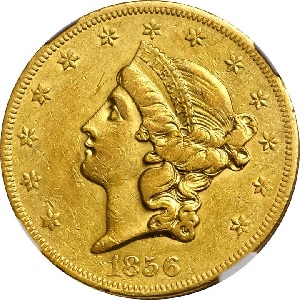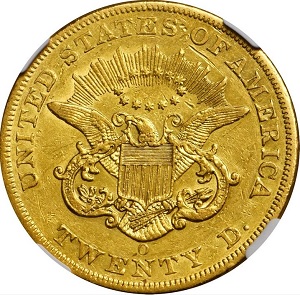1856-O Coronet $20 Double Eagle
The story of the 1856-O Coronet $20 double eagle closely parallels that of its New Orleans sibling, the 1854-O double eagle. These are two of the finest coins in United States numismatics.
Massive quantities of gold were uncovered in the California hills by a stampede rush of “49ers.” With no coining facility nearby, large shipments of the precious metal traveled thousands of miles to mints in New Orleans and Philadelphia. The most common route was by steamship to Panama, overland travel across the narrow isthmus, and then back on board another steamship on the Atlantic side. The journey was long and filled with danger.(1)
It only made sense to build a mint in close proximity to the California gold mines. After winning the approval of Congress, the new San Francisco Mint opened its doors for business in April 1854.
As soon as the west coast mint became operational, gold bullion deposits plunged drastically at New Orleans. Double eagle production fell accordingly, hitting rock-bottom in 1856, when just 2,250 twenties were struck. By comparison, nearly 1.2 million 1856-S double eagles were released.
Lack of bullion was not the only explanation for extremely low double eagle production at the New Orleans Mint during the final years of the antebellum era. Structural issues with the mint building’s foundation necessitated repairs that at times hampered manufacturing activity.
A focus on subsidiary silver coinage also consumed production capacity at New Orleans starting in 1853, when vast amounts of coins meeting the new silver reduction standard were needed in the economy. Out of concern for possible gold hoarding, Mint Director James R. Snowden decreed the Mint (except for the San Francisco branch facility) would no longer trade out gold coins for silver deposits, thus reducing demand for larger denomination gold.
Virtually the entire supply of 1856-O double eagles entered circulation immediately. It would take another 50 years or so before collectors finally got interested in tracking down certain dates by mintmark, but by then, all but a tiny handful of 1856-O examples had succumbed to the ravages of attrition.
We know of just one uncirculated specimen (with a prooflike finish!) existing today, worth a seven-figure sum.(2)
Fascinating Fact: In 1934, two teenage boys digging around in the cellar of an old Baltimore home stumbled upon a stash of 3,558 gold coins, all dated before 1857. Among them was a prized 1856-O double eagle. Described as “Very Fine”, the coin sold at auction in May 1935 for $105.(3) Their coin today is worth somewhere in the $200,000 range.
With an approximate survivorship of just 41 examples,(4) the 1856-O double eagle ranks as one of the most important dates in the entire U.S. gold coin series. For the advanced numismatist, acquiring an 1856-O is a dream come true, certain to elevate the prestige of any collection.
Douglas Winter and Adam Crum, authors of An Insider's Guide to Collecting Type I Double Eagles 1850-1866, had this to say:
"You can be finicky when selecting an 1856 Philadelphia or San Francisco double eagle. You cannot be finicky when selecting an 1856-O. Consider any chance to purchase an 1856-O double eagle a special opportunity."(5)
Judging by the spectacular value trends of the 1856-O, it would seem collectors for generations have taken this advice to heart.
| Estimated survivors in all grades: 41 ?
The survivor estimate from PCGS represents an average of one or more experts' opinions as to how many examples survive of a particular coin in all grades. Survival estimates include coins that are raw, certified by PCGS, and certified by other grading services. Learn more at PCGS. |
| PCGS Rarity Scale: 8.6 ?
The 'PCGS CoinFacts Rarity Scale' assesses the relative rarity of all U.S. coins, based on estimated surviving examples. The scale runs from 1.0 to 10.0. The higher the number, the rarer the coin.
Learn more at PCGS. |
| Click HERE to check for availability on eBay** |
Preview of eBay selection (it may take a while to find an 1856-O $20 for sale -- patience, grasshopper!):
 |
 |
| Trendline Avg = 37.29 | BEST |
Historic Value Trend Charts:
| Last updated 10-9-24 | Return to Key Date Coin List | |
| Compare to Common Date Coin of Same Type | ||
|
|
||
| Download Charts to Your Computer | ||
Sources
1. Heritage Auctions. 1856-O $20. Aug 2014 Auction.
2. Heritage Auctions. 1856-O $20 SP63. May 2009 Auction.
3. Bowers, Q. David. Gold Hidden in a Baltimore Cellar. Stack's Bowers Galleries, December 21, 2021.
4. PCGS. 1856-O $20 (Regular Strike).
5. Heritage Auctions. 1856-O $20. Aug 2014 Auction.
**Many very fine coin dealers sell on eBay. At any point in time, there may be over one million search results for United States coins. This includes quite a few of the recommendations on our Key Date Coin List.
If you’re thinking about purchasing a rare coin, eBay is certainly worth a look. For your convenience, the links from this site to eBay are coded to bring up only coins certified by PCGS and NGC.
As is always, always the case, never buy a valuable coin from a seller whose trustworthiness cannot be verified. Learn more about this at our chapter Best Places to Buy Coins, which also has a section on doing business on eBay.
In the interest of full disclosure, Rare Coins 101 receives a small commission anytime someone connects to eBay from this site and purchases something.
Coin images by Stack's Bowers Galleries.


